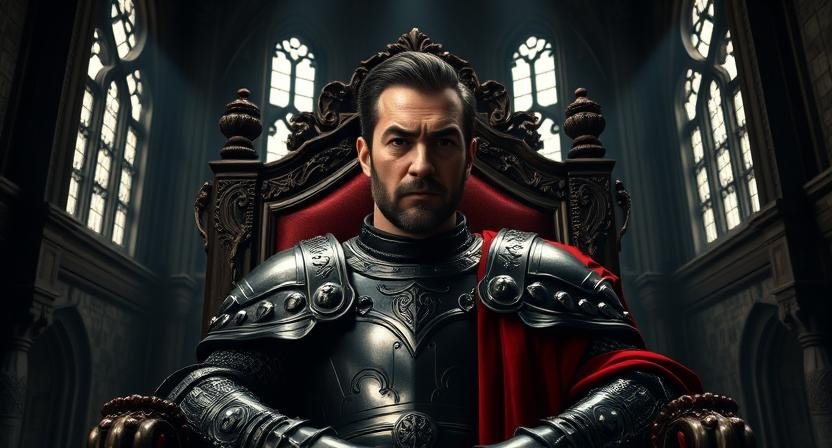In the pantheon of animated villains, few characters cast a shadow as long, or more accurately, as incongruously short, as Lord Farquaad from the 2001 classic Shrek. He is not a fire-breathing dragon nor a fairy-tale-obsessed fairy godmother. Instead, he is something far more relatable and, consequently, more terrifying: a bureaucrat with an ego as vast as his stature is small. Lord Farquaad represents a specific brand of evil—one born not from cosmic power, but from petty insecurity, ruthless ambition, and a desperate desire for legitimacy. This article delves into the character, motivations, and lasting impact of Duloc’s tyrannical ruler.
Table of Contents
The Man Behind the Castle: Who is Lord Farquaad?
Before analyzing his actions, it is crucial to understand who Lord Farquaad claims to be. He is the self-proclaimed ruler of the meticulously clean, sterile, and orderly kingdom of Duloc. His introduction is a masterpiece of character establishment. We see him before we hear him, a figure from behind, sitting on a massive throne, his long, flowing hair suggesting a man of power and grandeur. The camera then reveals the joke: the man is incredibly short, and his “long hair” is, in fact, a cape arranged to create a deliberate illusion. This visual gag perfectly encapsulates Farquaad’s entire being—a façade of power masking a profound inadequacy.
His title, “Lord,” is also significant. He is not a king. This suggests he may have usurped power or risen to his position through means other than royal birthright. The film provides no backstory of a noble lineage, hinting that his authority is self-made and therefore inherently fragile. This lack of traditional royal blood fuels his primary motivation: to become a real king by marrying a princess, thereby acquiring the legitimacy he so desperately craves.
The Architecture of Power: Duloc as an Extension of Farquaad’s Ego
A ruler’s domain often reflects their personality, and Duloc is a perfect mirror of Lord Farquaad. The kingdom is a monument to control, conformity, and sterility. Its design is geometric, symmetrical, and devoid of any organic chaos. The streets are paved, the houses are identical, and even the entertainment—a animatronic chorus singing a catchy jingle about the rules—is automated and soulless. This is a place where individuality is not just discouraged but systematically erased.
This obsession with order is a direct reaction to the “problem” of fairy tale creatures. To Farquaad, these beings—with their magic, their mess, their inherent unpredictability—represent everything he cannot control. They are the antithesis of his perfectly ordered world. His solution is not integration or understanding, but brutal segregation. He institutes a bounty system, having his knights round up every fairy tale creature and imprison them, effectively cleansing his kingdom of the “vermin.” This act of ethnic cleansing is presented with a comedic tone, but its implications are darkly authoritarian. It establishes Farquaad as a ruler who would rather eliminate a problem than manage it, a clear sign of his intolerance and fragility.
A Tyrant’s Toolkit: Farquaad’s Methods of Control
Lord Farquaad does not rely on personal strength or magical prowess. His power is administrative and militaristic, wielded from the safety of his castle.
- Delegation and Manipulation: Farquaad’s primary tool is delegation. He does not dirty his own hands. He organizes a tournament to find a champion to rescue Princess Fiona from the dragon-guarded tower. When Shrek (and his unwitting companion, Donkey) wins, Farquaad immediately shifts to a transactional approach. He offers Shrek a deal: retrieve the princess, and he will clear Shrek’s swamp of the exiled fairy tale creatures. This demonstrates a cunning, corporate-minded intelligence. He gets what he wants while making someone else do the dangerous work.
- The Illusion of Fairness: The tournament is a key example of Farquaad’s manipulation. It creates an illusion of meritocracy and fair play. However, the tournament is rigged, and his chosen knights are easily defeated by an ogre. This shows that his systems are just for show; the outcome he desires is the only one that matters.
- Theatricality and Propaganda: Farquaad understands the power of image. His planned wedding to Fiona is not just a political union; it is a spectacle designed to cement his status in the eyes of his subjects and the world. He is a master of propaganda, presenting himself as the heroic savior who bravely won the princess, completely erasing Shrek’s role from the narrative.
The Insecurity Complex: How Height Defines a Villain
It is impossible to discuss Lord Farquaad without addressing his most famous characteristic: his height. The film uses his short stature as a constant source of humor, but it is also the key to his psychology. Nearly every aspect of his behavior can be interpreted as overcompensation for his physical size.
His castle is comically large, with towering ceilings and enormous furniture, making him appear even smaller. His throne is massive, and he requires a small ladder to climb into it. He is often filmed from low angles to give an illusion of height, but these shots frequently end with a cutaway that emphasizes his true size. His aggressive, domineering personality, his desire for a tall, powerful castle, and his quest for a “perfect” princess are all attempts to project a grandeur that he physically lacks. He is the embodiment of the “Napoleon complex,” a man whose ambition is fueled by a deep-seated insecurity.
Lord Farquaad’s Legacy: More Than Just a Punchline
While his end is swift and undignified—swallowed whole by a dragon—Lord Farquaad’s impact on animation and villainy is significant. He broke the mold of the traditional animated antagonist. Before him, villains were often grand sorcerers or evil queens. Farquaad proved that a villain could be effective without any magical powers. His evil is bureaucratic, petty, and chillingly realistic. He is a symbol of authoritarianism, gentrification, and the dangers of a leader who prioritizes order over compassion and image over substance.
He set the stage for a new kind of animated villain: the insecure, relatable, and politically savvy antagonist. His influence can be seen in characters like Mayor Bellwether from Zootopia, another seemingly small and harmless figure who uses systemic power to enact a prejudiced agenda. Lord Farquaad remains a timeless character because his brand of villainy is not confined to fairy tales; it is one we can recognize in the real world.
Informational FAQs about Lord Farquaad
Q1: What is the correct pronunciation of “Farquaad”?
A1: It is pronounced “FAR-quad.” The name is a deliberate play on the vulgar English word “f**kwad,” which is a term for an obnoxious or contemptible person, fitting his character perfectly.
Q2: Who was the voice actor for Lord Farquaad?
A2: Lord Farquaad was brilliantly voiced by the English actor John Lithgow. Lithgow brought a perfect blend of pomposity, petulance, and underlying insecurity to the character.
Q3: Did Lord Farquaad have any magical abilities?
A3: No, Lord Farquaad possessed no magical powers whatsoever. His strength came entirely from his political position, his army of knights, and his ruthless cunning.
Q4: What was the name of Lord Farquaad’s castle and kingdom?
A4: He ruled from the massive Duloc Castle, located in the center of his kingdom, Duloc.
Q5: Why did Lord Farquaad want to marry Princess Fiona specifically?
A5: Marrying Princess Fiona was the final step in his plan to become a true king. As a princess (and one from a royal bloodline, as he believed), their union would grant him the legitimate royal title he craved, transforming him from a “Lord” into a “King.”

